The Spilled Smoothie Saga
Ah, the bane of every tech enthusiast’s existence – liquid damage. It’s a problem that strikes without warning, leaving us scrambling to save our beloved devices from a watery grave. But fear not, my friends! I’ve been in your shoes, and I’m here to share my hard-earned wisdom on how to resurrect your electronics from the depths of liquid disaster.
Step 1: Act Fast
The moment you realize your device has taken a plunge into the unknown, the first and most crucial step is to cut the power. [1] Disconnect any power source as quickly as possible to prevent further damage. This could mean unplugging your laptop, removing the battery from your smartphone, or flipping the switch on your desktop computer.
Next, identify the culprit. Is it a mischievous coffee spill, a rogue splash from the kitchen sink, or perhaps a sudden encounter with a smoothie? Knowing the nature of the liquid can give you a clue about the severity of the damage. [2] A neutral pH solution, like water, is generally less harmful than an acidic or alkaline liquid, which can wreak havoc on delicate electronic components.
Drying Out the Damage
Now, the real work begins. Gently remove the affected device from the liquid and begin the drying process. The goal is to remove as much moisture as possible, but you’ll need to be cautious not to cause any further harm.
Start by using a clean, absorbent cloth or paper towels to gently blot the affected areas. Avoid rubbing or wiping, as this could push the liquid deeper into the device. [3] Once you’ve removed the obvious surface moisture, it’s time to get creative.
The Rice Trick
You’ve probably heard of the classic “rice trick” for drying out water-damaged electronics. [4] Well, there’s a reason it’s a go-to technique – it works! Simply place your device in an airtight container, such as a Ziploc bag or an airtight container, and surround it with uncooked rice. The rice will act as a desiccant, absorbing the remaining moisture over the next 24-48 hours.
Air Drying
If you’re not a fan of the rice method, or if the damage is more extensive, you can try air drying. [5] Place your device in a well-ventilated area, away from direct heat or sunlight. A fan can be helpful to circulate the air, but be cautious not to blow the device around too much.
Alcohol Rinse
For stubborn cases, you can consider an alcohol rinse. [6] Isopropyl alcohol, also known as rubbing alcohol, can help remove any lingering moisture and clean the affected components. Carefully disassemble your device, if possible, and use a clean, soft-bristled brush to gently apply the alcohol to the affected areas. Just be sure to let it dry completely before reassembling.
Assess the Damage
Once your device has had ample time to dry, it’s time to assess the damage. [7] Carefully inspect the affected areas, looking for any visible signs of corrosion, discoloration, or physical damage. If you’re unsure, it’s always better to err on the side of caution and seek professional help.
Repair and Reassemble
If the damage is minimal, you may be able to proceed with the repair yourself. [8] Carefully clean any affected components with a soft-bristled brush and isopropyl alcohol, and check for any loose connections or damaged parts that need to be replaced.
When it comes to reassembly, take your time and follow any manufacturer instructions carefully. Rushing through this process could lead to further complications down the line.
Crossing Your Fingers
With your device carefully repaired and reassembled, all that’s left to do is cross your fingers and hope for the best. Power on your device and pray that the liquid damage hasn’t caused any lasting harm. If all goes well, you’ll be back in business, ready to face the next liquid-related challenge that life throws your way.
Remember, prevention is always better than cure, so be mindful of your surroundings and take care when enjoying your favorite beverages near your precious electronics. But even if the unthinkable happens, now you’re armed with the knowledge to tackle it head-on. Happy repairing, my friends!
[1] https://www.ifixit.com/Wiki/Electronics_Water_Damage
[2] https://www.eevblog.com/forum/repair/repairing-water-damaged-electronics/
[3] https://www.reddit.com/r/LifeProTips/comments/6fdljr/lpt_15_years_repairing_electronics_here_with/
[4] https://callservicefirst.com/does-water-permanently-ruin-electronics/
[5] https://www.chemtronics.com/how-to-restore-flood-damaged-electronics-telecom-equipment-and-fiber-optic-connectors
[6] https://www.quora.com/Is-it-possible-to-wash-liquid-damaged-electronics-with-alcohol
[7] http://www.rccrawler.com/forum/electronics/39944-howto-repair-water-damaged-electronics.html
[8] https://blog.acsindustrial.com/industrial-electronic-repair-services/how-to-tell-if-your-water-damaged-circuit-boards-can-be-repaired/













